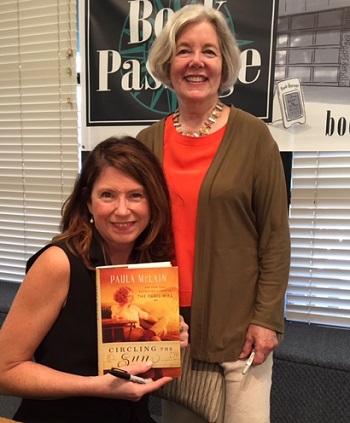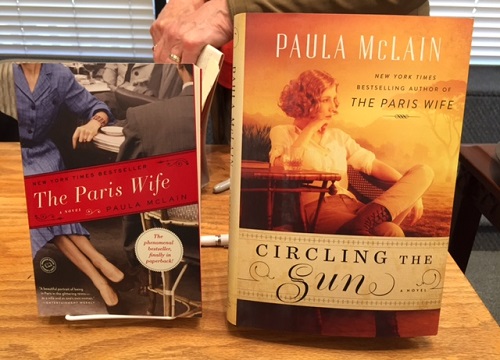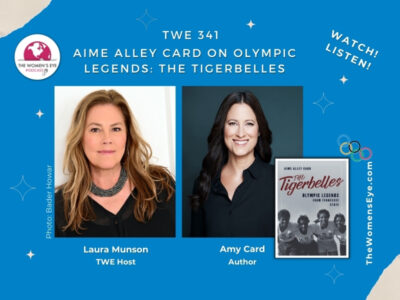
Update 6-5-18: Paula is getting great reviews for her newest historical fiction, Love and Ruin, the story of Ernest Hemingway and writer/journalist Martha Gellhorn.
by Laurie McAndish King/November 16, 2015
Photos: Pamela Burke
“The genre is completely addictive to me. It’s almost like every step of my journey as a writer has been leading up to historical fiction. It allows me to use all my gifts as a writer – my empathy, my curiosity.” Paula McLain
Paula McLain didn’t plan to write breathtaking historical fiction; her sights were set on poetry. She worked hard at it, earning an MFA in poetry from the University of Michigan while single-parenting her toddler. She published two books of verse, a memoir about growing up in the foster-care system in California, and a contemporary novel … and then came The Paris Wife (@randomhouse). McLain hit her stride with historical fiction.
That book, published in 2011, is a fictionalized account of Ernest Hemingway’s first marriage and early years in 1920s Paris, told from the perspective of his wife, Hadley. Friends were raving about The Paris Wife and I knew McLain had just published a second piece of historical fiction, Circling the Sun, so I was delighted to hear her speak at Book Passage in Corte Madera, California.
Looking lean and graceful in a black jacket and lively pearl earrings, McLain radiates warmth. She talks with both hands, and her right arm clearly has a life of its own. She flips her long brown hair, enthusiastically.
Before she wrote The Paris Wife, McLain says, she had a problem. “I hadn’t yet had a big idea, and I wasn’t sure how to find one. It was by fluke that I stumbled onto A Moveable Feast. I was moved to tears by the love story. When Hemingway believes his own genius … I wanted to know more. Who was she? What really happened, so that they lost each other?”
McLain read two biographies of Hadley. “I let the first fall open, and a letter from Hadley leapt off the page at me. This is my girl,” I thought. “This is my book!” McLain quit her teaching job (she was actually working three teaching jobs at the time) and borrowed some money. She wrote every day in a Starbucks in Cleveland – which, McLain points out, is the absolute farthest one can possibly get from a Parisian café.
“I had never done research before. I didn’t know what I didn’t know. I had never even been to Paris. It was almost as if I was channeling her, like an actress in the role of my life,” McLain remembers.
In the John F. Kennedy Presidential Library, she found a treasure trove of love letters–thousands of letters that she could “follow down the rabbit hole” into Ernest and Hadley Hemingway’s exuberant life in Jazz-Age Paris. “Hadley had burned all her letters from Ernest, but he kept everything. It was like a ghost chase.”
A member of the audience asks McLain how she managed to recreate Hadley’s dialog. “How do you get into their heads? How much is fact, and how much is fiction?”
“Because it is a novel, you can say anything,” McLain explains. But due to copyright issues, she was not allowed to use any two words together that her subjects had actually written. “Getting inside her head was like an actor’s trick. I had read so many of her letters … I also love what is not being said. Really good dialog is people not saying what’s on their minds.”
The Paris Wife was told from the perspective of a relatively unknown historical figure. It included “no detectives, no porn, and no death on page three.” Yet it hit the New York Times bestseller list – and stayed there for 77 weeks.
“The genre is completely addictive to me,” she explains. “It’s almost like every step of my journey as a writer has been leading up to historical fiction. It allows me to use all my gifts as a writer–my empathy, my curiosity.”
The Paris Wife was named one of the best books of the year by People, the Chicago Tribune, NPR, The Philadelphia Inquirer, Kirkus Reviews, and the Toronto Sun. It sold 1.6 million copies. And that presented a new problem.
BEA Librarians’ Breakfast on “Circling the Sun”/Penguin Random House-2015
It was time for a follow up. Readers were asking McLain what she was writing next. She had started novel about Marie Curie, another extraordinary and underappreciated woman, and worked on it for two and a half years. But the story was boring. “It felt like pushing a mannequin in a shopping cart,” McLain recalls.A nudge from her brother-in-law introduced McLain to West with the Night, the memoir of history-making aviator Beryl Markham. Markham’s achievements alone might have captured McLain’s attention.

She was a daring bush pilot in 1920s Kenya; the first person to successfully hunt big game from the air; the first licensed female horse trainer in the world; one of the first people in the world to hold a commercial pilot’s license; and, in 1936, the first woman to fly the Atlantic east to west–the hard way. In McLain’s words, “Markham was a real badass.”
Then there was Markham’s personal story. She suffered incredible losses early in life, somehow managed to draw strength from them, and grew into an exceptional and fearless woman.
She lived a dramatic life as part of a circle of glamorous British and European expats and had affairs with a prince and a duke–not to mention her part in the decade-long love triangle with Danish writer Baroness Karen Blixen and Denys Finch Hatton, a charismatic hunter and pilot. “She lived like Calamity Jane and she looked like Great Garbo,” McLain observes.
But there was still more that drew McLain to Markham; the two shared surprisingly similar backgrounds. Both were abandoned at age four by their mothers and felt the loss deeply. Their mothers were both gone for 16 years, reappearing when their daughters were 20 and making the girls’ lives extremely complicated. Both McLain and Markham were married at age 34. “We share emotional DNA,” McLain says.
And finally there was Markham’s own voice, reaching out from the pages of West with the Night, and captivating McLain. “Within two paragraphs of reading West with the Night, I knew I would write about Markham,” she says. And write she did. Paula McLain’s new book, Circling the Sun, is a fictionalized account of Markham’s life, and it’s getting rave reviews.
McLain is getting rave reviews, too. Here’s what Ann Patchett says in Country Living, “Paula McLain is considered the new star of historical fiction, and for good reason. Circling the Sun … is both beautifully written and utterly engrossing.”
The audience members at Book Passage are eager to hear what McLain is up to next: Is she working on a novel? Will it be about another extraordinary woman? “Will a man ever inspire you that way?” someone asks.
“It’s these women’s lives that are capturing my imagination and magnetizing it,” McLain responds, flipping her hair back. She clearly has someone in mind, and it’s my guess that we’ll soon be treated to another lush piece of inspired historical fiction. In the meantime, I’m tucking into Circling the Sun.
##
Some links in this post may be “affiliate links,” meaning TWE receives a small commission (at no extra cost to you) if you use that link to make a purchase.




Great review!! “Circling the Sun” is probably my favorite book of 2015. When I first saw the cover, long before it was released, I knew it was a book I wanted to read. Once I was able to get my hands on it, I read it in a couple of days, non-stop. I work in a small town public library. When someone comes in and asks for a good book, this book is the first I recommend for a good historical fiction read — heck, a good read of any kind!! Thank you Women’s Eye for a great review. Thank you Paula McLain for a great book!! I look forward to the next surprise from both of you!!
Thanks for your comments, Lynn. We really enjoy Paula’s books as well and are looking forward to her next one!